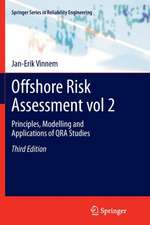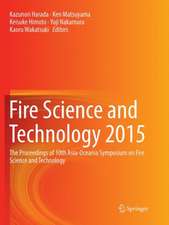Offshore Risk Assessment Vol. 1: Principles, Modelling and Applications of QRA Studies: Springer Series in Reliability Engineering
Autor Jan-Erik Vinnem, Willy Røeden Limba Engleză Paperback – 20 sep 2020
Separate chapters analyse the main hazards for offshore structures: fire, explosion, collision, and falling objects, as well as structural and marine hazards. Risk mitigation and control are discussed, as well as how the results of quantitative risk assessment studies should be presented. The fourth edition presents updated hydrocarbon release statistics, together withnew methods for modelling the risk from ignited hydrocarbon releases. There have been recent advances in the modelling of collision risk from passing and attending vessels, based on extensive research; these advances are described in detail, in addition to new developments in the safety of Dynamic Positioning vessels. In closing, the book provides updated statistics and lessons learned from accidents involving offshore helicopter transportation of personnel.
The book offers a comprehensive reference guide for academics and students of marine/offshore risk assessment and management. It will also be of interest to professionals in the industry, as well as contractors, suppliers, consultants and regulatory authorities.
| Toate formatele și edițiile | Preț | Express |
|---|---|---|
| Paperback (1) | 541.85 lei 43-57 zile | |
| SPRINGER LONDON – 20 sep 2020 | 541.85 lei 43-57 zile | |
| Hardback (1) | 717.77 lei 43-57 zile | |
| SPRINGER LONDON – 20 sep 2019 | 717.77 lei 43-57 zile |
Din seria Springer Series in Reliability Engineering
- 18%
 Preț: 1122.56 lei
Preț: 1122.56 lei - 20%
 Preț: 1277.89 lei
Preț: 1277.89 lei - 20%
 Preț: 987.32 lei
Preț: 987.32 lei - 18%
 Preț: 1406.66 lei
Preț: 1406.66 lei - 24%
 Preț: 1048.67 lei
Preț: 1048.67 lei - 20%
 Preț: 940.32 lei
Preț: 940.32 lei - 18%
 Preț: 952.09 lei
Preț: 952.09 lei -
 Preț: 313.32 lei
Preț: 313.32 lei - 18%
 Preț: 951.29 lei
Preț: 951.29 lei - 18%
 Preț: 947.02 lei
Preț: 947.02 lei - 15%
 Preț: 651.51 lei
Preț: 651.51 lei - 18%
 Preț: 1228.44 lei
Preț: 1228.44 lei - 18%
 Preț: 1227.67 lei
Preț: 1227.67 lei - 18%
 Preț: 952.89 lei
Preț: 952.89 lei - 18%
 Preț: 1234.94 lei
Preț: 1234.94 lei - 18%
 Preț: 1236.19 lei
Preț: 1236.19 lei - 18%
 Preț: 952.09 lei
Preț: 952.09 lei - 15%
 Preț: 635.65 lei
Preț: 635.65 lei - 20%
 Preț: 1274.57 lei
Preț: 1274.57 lei - 18%
 Preț: 1322.35 lei
Preț: 1322.35 lei - 15%
 Preț: 643.34 lei
Preț: 643.34 lei - 18%
 Preț: 1109.16 lei
Preț: 1109.16 lei - 15%
 Preț: 635.65 lei
Preț: 635.65 lei - 15%
 Preț: 654.62 lei
Preț: 654.62 lei - 18%
 Preț: 944.99 lei
Preț: 944.99 lei - 18%
 Preț: 953.65 lei
Preț: 953.65 lei - 18%
 Preț: 956.50 lei
Preț: 956.50 lei - 15%
 Preț: 644.95 lei
Preț: 644.95 lei - 18%
 Preț: 950.52 lei
Preț: 950.52 lei - 18%
 Preț: 1233.97 lei
Preț: 1233.97 lei - 15%
 Preț: 640.06 lei
Preț: 640.06 lei - 18%
 Preț: 956.69 lei
Preț: 956.69 lei - 18%
 Preț: 940.39 lei
Preț: 940.39 lei - 18%
 Preț: 948.92 lei
Preț: 948.92 lei -
 Preț: 389.70 lei
Preț: 389.70 lei - 18%
 Preț: 943.73 lei
Preț: 943.73 lei - 18%
 Preț: 1213.16 lei
Preț: 1213.16 lei - 18%
 Preț: 940.57 lei
Preț: 940.57 lei - 20%
 Preț: 985.03 lei
Preț: 985.03 lei - 18%
 Preț: 943.43 lei
Preț: 943.43 lei - 18%
 Preț: 1218.21 lei
Preț: 1218.21 lei - 18%
 Preț: 948.16 lei
Preț: 948.16 lei - 18%
 Preț: 948.92 lei
Preț: 948.92 lei - 18%
 Preț: 1727.24 lei
Preț: 1727.24 lei - 15%
 Preț: 638.43 lei
Preț: 638.43 lei
Preț: 541.85 lei
Preț vechi: 637.48 lei
-15% Nou
Puncte Express: 813
Preț estimativ în valută:
103.68€ • 108.54$ • 85.79£
103.68€ • 108.54$ • 85.79£
Carte tipărită la comandă
Livrare economică 07-21 aprilie
Preluare comenzi: 021 569.72.76
Specificații
ISBN-13: 9781447174462
ISBN-10: 1447174461
Pagini: 552
Ilustrații: XXXVIII, 552 p. 173 illus., 26 illus. in color.
Dimensiuni: 155 x 235 mm
Greutate: 0.82 kg
Ediția:4th ed. 2020
Editura: SPRINGER LONDON
Colecția Springer
Seria Springer Series in Reliability Engineering
Locul publicării:London, United Kingdom
ISBN-10: 1447174461
Pagini: 552
Ilustrații: XXXVIII, 552 p. 173 illus., 26 illus. in color.
Dimensiuni: 155 x 235 mm
Greutate: 0.82 kg
Ediția:4th ed. 2020
Editura: SPRINGER LONDON
Colecția Springer
Seria Springer Series in Reliability Engineering
Locul publicării:London, United Kingdom
Cuprins
Part I.- 1.Introduction.- 2.Risk Picture: Definitions and Characteristics.- 3.Risk Assessment process and Main Elements.- 4.Lessons from Major Accidents.- 5.Lessons from Macondo Accident.- Part II.- 6.The Occurrence of Hydrocarbon Leaks: Process Systems.- 7.Fire Risk Modelling.- 8.Explosion Risk Modelling.- 9.Collision Risk Modelling.- 10.Marine Systems Risk Modelling.- 11.Risk due to Miscellaneous Hazards.- 12.Fatality Risk Assessment.- 13.Helicopter Transportation Fatality Risk Assessment.
Recenzii
“The book is useful for academics and students, as well as for professionals in the sector and regulatory authorities.” (Emilia Di Lorenzo, zbMATH 1427.91003, 2020)
Notă biografică
Jan Erik Vinnem is a Professor of marine operational risk at the Norwegian University of Science and Technology, Trondheim, Norway. He is also a specialist advisor and CEO of Preventor AS, a consultancy in risk management to the Norwegian offshore industry. His professional career includes experience in the petroleum industry (Statoil and Total), and work as a private consultant (as the founder of Safetec Nordic AS and Preventor AS), in addition to his time in research and education. His research interests include decision support tools, risk management, risk tolerance, risk analysis methods, and risk assessments reflecting human and organisational factors.
Dr. Willy Røed has more than twenty years experience as a consultant within risk assessment and risk management from many different application areas, including oil & gas, transport and public sector. He is presently Senior Risk Management analyst in the consultancy company Proactima. He has a master degree and PhD in risk management from University of Stavanger, Norway, and is currently also adjunct Professor at this university. Røed is Chair of the SRA Applied Risk Management Specialty Group.
Textul de pe ultima copertă
This is the first textbook to address quantified risk assessment (QRA) as specifically applied to offshore installations and operations. As the first part of the two-volume updated and expanded fourth edition, it adds a new focus on the EU Offshore Safety Directive, and discusses the new perspective on risk from the Norwegian Petroleum Safety Authority, followed by new and updated international standards. New safety statistics for the Norwegian sectors are presented, as well as new case studies on international offshore accidents, such as the explosion on FPSO Sao Mateus in 2015, which involved 9 fatalities.
Separate chapters analyse the main hazards for offshore structures: fire, explosion, collision, and falling objects, as well as structural and marine hazards. Risk mitigation and control are discussed, as well as how the results of quantitative risk assessment studies should be presented. The fourth edition presents updated hydrocarbon release statistics, together withnew methods for modelling the risk from ignited hydrocarbon releases. There have been recent advances in the modelling of collision risk from passing and attending vessels, based on extensive research; these advances are described in detail, in addition to new developments in the safety of Dynamic Positioning vessels. In closing, the book provides updated statistics and lessons learned from accidents involving offshore helicopter transportation of personnel.
The book offers a comprehensive reference guide for academics and students of marine/offshore risk assessment and management. It will also be of interest to professionals in the industry, as well as contractors, suppliers, consultants and regulatory authorities.
Separate chapters analyse the main hazards for offshore structures: fire, explosion, collision, and falling objects, as well as structural and marine hazards. Risk mitigation and control are discussed, as well as how the results of quantitative risk assessment studies should be presented. The fourth edition presents updated hydrocarbon release statistics, together withnew methods for modelling the risk from ignited hydrocarbon releases. There have been recent advances in the modelling of collision risk from passing and attending vessels, based on extensive research; these advances are described in detail, in addition to new developments in the safety of Dynamic Positioning vessels. In closing, the book provides updated statistics and lessons learned from accidents involving offshore helicopter transportation of personnel.
The book offers a comprehensive reference guide for academics and students of marine/offshore risk assessment and management. It will also be of interest to professionals in the industry, as well as contractors, suppliers, consultants and regulatory authorities.
Caracteristici
Provides a detailed overview of all aspects of quantified risk assessment (QRA), making it an essential guide for graduate students, researchers, consultants, and safety authorities Adds a new focus on the EU Offshore Safety Directive and case studies on worldwide offshore accidents Includes new statistics and reports on offshore helicopter transportation





















